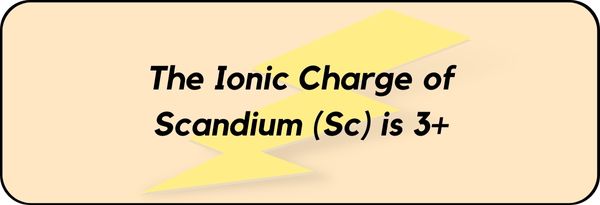
The Ionic Charge of Scandium (Sc) is 3+.
But the question is how can you find the ionic charge on Scandium (Sc)?
The ionic charge of scandium depends on what it is bonded with.
So let’s try to find out the ionic charge of Scandium (Sc) using some examples.
You can also refer to the below video from which you will learn to find charge of any ion.
How to find the ionic charge of Scandium (Sc)?
As I mentioned earlier, the ionic charge of Scandium (Sc) can be found out by looking at what it is bonded with.
So let’s take examples of compounds of Scandium (Sc) like ScCl3, ScF3, Sc2O3, etc.
Example 1: ScCl3
In ScCl3, the Scandium (Sc) is bonded to Chlorine (Cl).
You know that the ionic charge of Cl is 1-.
So you can easily say that the ionic charge of Sc should be 3+, then only it will get canceled out.
Hence the ionic charge of Scandium in ScCl3 is 3+.
Example 2: ScF3
In ScF3, the Scandium (Sc) is bonded to Fluorine (F).
And again, you know that the ionic charge of F is 1-.
So here also you can easily say that the ionic charge of Sc should be 3+, then only it will get canceled out.
Hence the ionic charge of Scandium in ScF3 is 3+.
Example 3: Sc2O3
Similarly in Sc2O3, the Scandium (Sc) is bonded to Oxygen (O).
And you know that the ionic charge of O is 2-.
So from this, you can easily say that the ionic charge of Sc should be 3+, then only it will get canceled out.
Hence the ionic charge of Scandium in Sc2O3 is 3+.
In this way, charge of Scandium depends on what it is bonded to.
As seen from the above examples,
The charge of Scandium (Sc) is 3+.
I hope you have understood why scandium has 3+ ionic charge.
Check out some other related topics for your practice.
Related topics:
Charge of Platinum (Pt)
Charge on NO
Charge of Xenon (Xe)
Charge of Bismuth (Bi)
Charge on H2O2
Jay is an educator and has helped more than 100,000 students in their studies by providing simple and easy explanations on different science-related topics. With a desire to make learning accessible for everyone, he founded Knords Learning, an online learning platform that provides students with easily understandable explanations.
Read more about our Editorial process.
